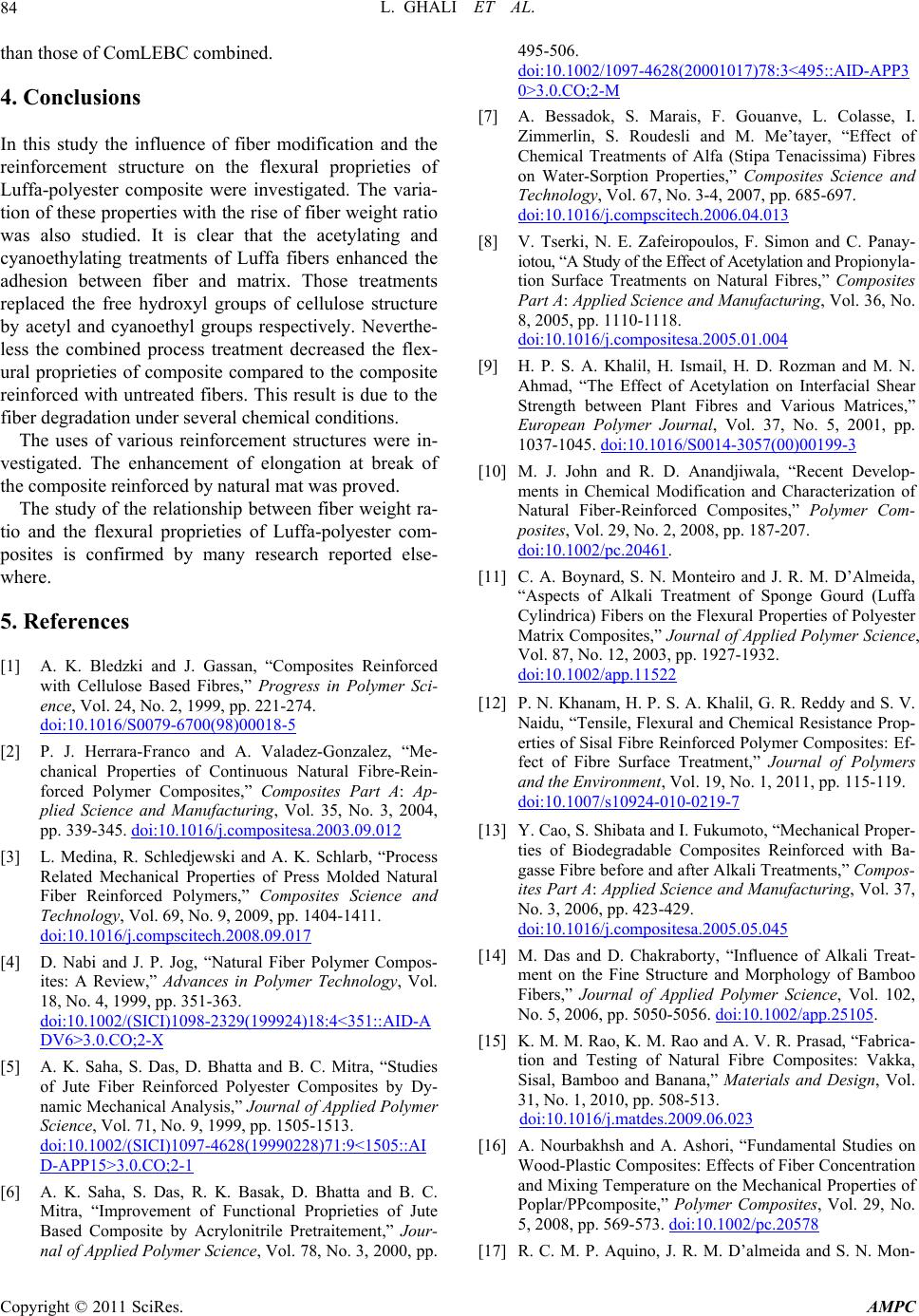
L. GHALI ET AL.
Copyright © 2011 SciRes. AMPC
84
than those of ComLEBC combined.
4. Conclusions
In this study the influence of fiber modification and the
reinforcement structure on the flexural proprieties of
Luffa-polyester composite were investigated. The varia-
tion of these properties with the rise of fiber weight ratio
was also studied. It is clear that the acetylating and
cyanoethylating treatments of Luffa fibers enhanced the
adhesion between fiber and matrix. Those treatments
replaced the free hydroxyl groups of cellulose structure
by acetyl and cyanoethyl groups respectively. Neverthe-
less the combined process treatment decreased the flex-
ural proprieties of composite compared to the composite
reinforced with untreated fibers. This result is due to the
fiber degradation under several chemical conditions.
The uses of various reinforcement structures were in-
vestigated. The enhancement of elongation at break of
the composite reinforced by natural mat was proved.
The study of the relationship between fiber weight ra-
tio and the flexural proprieties of Luffa-polyester com-
posites is confirmed by many research reported else-
where.
5. References
[1] A. K. Bledzki and J. Gassan, “Composites Reinforced
with Cellulose Based Fibres,” Progress in Polymer Sci-
ence, Vol. 24, No. 2, 1999, pp. 221-274.
doi:10.1016/S0079-6700(98)00018-5
[2] P. J. Herrara-Franco and A. Valadez-Gonzalez, “Me-
chanical Properties of Continuous Natural Fibre-Rein-
forced Polymer Composites,” Composites Part A: Ap-
plied Science and Manufacturing, Vol. 35, No. 3, 2004,
pp. 339-345. doi:10.1016/j.compositesa.2003.09.012
[3] L. Medina, R. Schledjewski and A. K. Schlarb, “Process
Related Mechanical Properties of Press Molded Natural
Fiber Reinforced Polymers,” Composites Science and
Technology, Vol. 69, No. 9, 2009, pp. 1404-1411.
doi:10.1016/j.compscitech.2008.09.017
[4] D. Nabi and J. P. Jog, “Natural Fiber Polymer Compos-
ites: A Review,” Advances in Polymer Technology, Vol.
18, No. 4, 1999, pp. 351-363.
doi:10.1002/(SICI)1098-2329(199924)18:4<351::AID-A
DV6>3.0.CO;2-X
[5] A. K. Saha, S. Das, D. Bhatta and B. C. Mitra, “Studies
of Jute Fiber Reinforced Polyester Composites by Dy-
namic Mechanical Analysis,” Journal of Applied Polymer
Science, Vol. 71, No. 9, 1999, pp. 1505-1513.
doi:10.1002/(SICI)1097-4628(19990228)71:9<1505::AI
D-APP15>3.0.CO;2-1
[6] A. K. Saha, S. Das, R. K. Basak, D. Bhatta and B. C.
Mitra, “Improvement of Functional Proprieties of Jute
Based Composite by Acrylonitrile Pretraitement,” Jour-
nal of Applied Polymer Science, Vol. 78, No. 3, 2000, pp.
495-506.
doi:10.1002/1097-4628(20001017)78:3<495::AID-APP3
0>3.0.CO;2-M
[7] A. Bessadok, S. Marais, F. Gouanve, L. Colasse, I.
Zimmerlin, S. Roudesli and M. Me’tayer, “Effect of
Chemical Treatments of Alfa (Stipa Tenacissima) Fibres
on Water-Sorption Properties,” Composites Science and
Technology, Vol. 67, No. 3-4, 2007, pp. 685-697.
doi:10.1016/j.compscitech.2006.04.013
[8] V. Tserki, N. E. Zafeiropoulos, F. Simon and C. Panay-
iotou, “A Study of the Effect of Acetylation and Propionyla-
tion Surface Treatments on Natural Fibres,” Composites
Part A: Applied Science and Manufacturing, Vol. 36, No.
8, 2005, pp. 1110-1118.
doi:10.1016/j.compositesa.2005.01.004
[9] H. P. S. A. Khalil, H. Ismail, H. D. Rozman and M. N.
Ahmad, “The Effect of Acetylation on Interfacial Shear
Strength between Plant Fibres and Various Matrices,”
European Polymer Journal, Vol. 37, No. 5, 2001, pp.
1037-1045. doi:10.1016/S0014-3057(00)00199-3
[10] M. J. John and R. D. Anandjiwala, “Recent Develop-
ments in Chemical Modification and Characterization of
Natural Fiber-Reinforced Composites,” Polymer Com-
posites, Vol. 29, No. 2, 2008, pp. 187-207.
doi:10.1002/pc.20461.
[11] C. A. Boynard, S. N. Monteiro and J. R. M. D’Almeida,
“Aspects of Alkali Treatment of Sponge Gourd (Luffa
Cylindrica) Fibers on the Flexural Properties of Polyester
Matrix Composites,” Journal of Applied Polymer Science,
Vol. 87, No. 12, 2003, pp. 1927-1932.
doi:10.1002/app.11522
[12] P. N. Khanam, H. P. S. A. Khalil, G. R. Reddy and S. V.
Naidu, “Tensile, Flexural and Chemical Resistance Prop-
erties of Sisal Fibre Reinforced Polymer Composites: Ef-
fect of Fibre Surface Treatment,” Journal of Polymers
and the Environment, Vol. 19, No. 1, 2011, pp. 115-119.
doi:10.1007/s10924-010-0219-7
[13] Y. Cao, S. Shibata and I. Fukumoto, “Mechanical Proper-
ties of Biodegradable Composites Reinforced with Ba-
gasse Fibre before and after Alkali Treatments,” Compos-
ites Part A: Applied Science and Manufacturing, Vol. 37,
No. 3, 2006, pp. 423-429.
doi:10.1016/j.compositesa.2005.05.045
[14] M. Das and D. Chakraborty, “Influence of Alkali Treat-
ment on the Fine Structure and Morphology of Bamboo
Fibers,” Journal of Applied Polymer Science, Vol. 102,
No. 5, 2006, pp. 5050-5056. doi:10.1002/app.25105.
[15] K. M. M. Rao, K. M. Rao and A. V. R. Prasad, “Fabrica-
tion and Testing of Natural Fibre Composites: Vakka,
Sisal, Bamboo and Banana,” Materials and Design, Vol.
31, No. 1, 2010, pp. 508-513.
doi:10.1016/j.matdes.2009.06.023
[16] A. Nourbakhsh and A. Ashori, “Fundamental Studies on
Wood-Plastic Composites: Effects of Fiber Concentration
and Mixing Temperature on the Mechanical Properties of
Poplar/PPcomposite,” Polymer Composites, Vol. 29, No.
5, 2008, pp. 569-573. doi:10.1002/pc.20578
[17] R. C. M. P. Aquino, J. R. M. D’almeida and S. N. Mon-